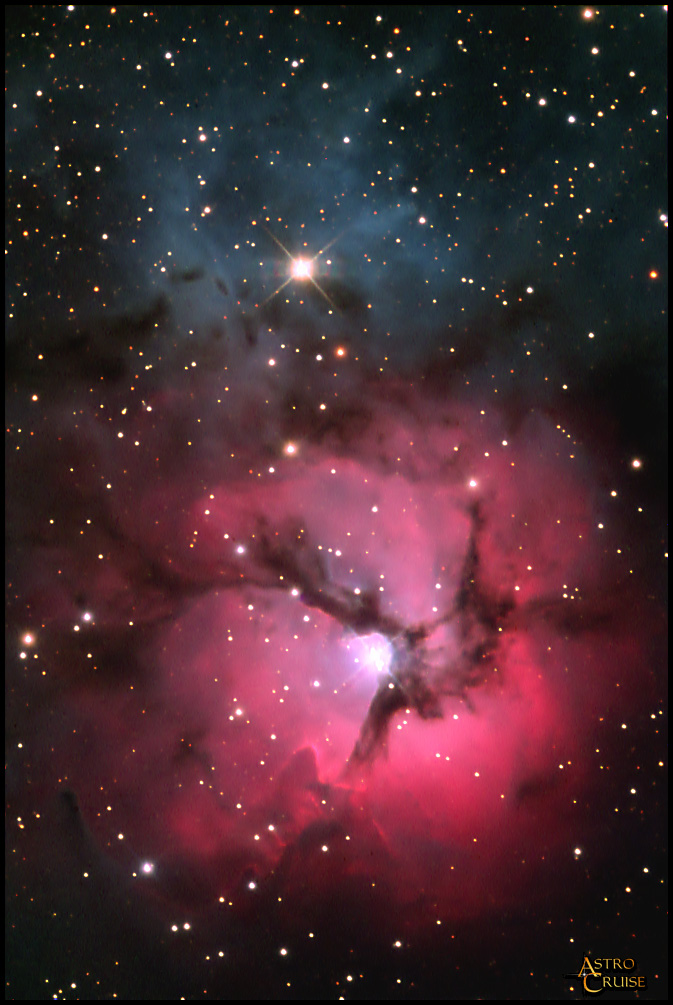
 |
Object Data: Messier 20, (NGC 6514), the Trifid Nebula, is a bright nebulous region in the western part of Sagittarius, about 1.3 degrees to the north of the Lagoon Nebula. This spectacular object is a rare combination of very bright emission and reflection nebulae. The strikingly different colours are due to different effects within the vast clouds of hydrogen gas and dust that comprise the nebula. The southern part is a region where new stars are being formed; here the very hot young stars emit enough radiation to ionize the hydrogen, causing it to emit light on the Ha (656nm) spectral line which is in the deep red part of the visible spectrum. But there is also a strong broadband light component to the nebula; within and surrounding the entire nebula are masses of tiny dust particles which reflect the starlight generally, and blue light particularly. This can be seen most clearly in the northen part of the nebula where the hydrogen gas has become exhausted and only the dust remains to reflect the light from the hot young stars, most especially the bright magnitude 7.3 star in the centre of the blue reflection region. In parts of the nebula there is so much dust that it hides the nebula, producing the three dark lanes which caused William Herschel to give the Trifid Nebula its name. Measuring some forty light years across, this nebula is believed to be about 5,200 light years distant. It was catalogued and given the designation M20 by Messier in June 1764.
Date: 15/06/02
Location: Southern France
Conditions: calm, transparency=8, seeing=9 (zero Jetstream)
Optics: RCOS Ritchey-Chretien 12.5" f/9 working at f/6.7 with AP x.75 focal reducer.
Mount: AP 900 GTO on Portable Pier
Camera: SBIG ST-8E / CFW-8
Guiding: Integral ST-8E guiding chip controlled via MaximCCD
Exposure: High resolution RGB (no binning): 30:30:45 minutesProcessing: Image acquisition, calibration, combining, and DDP were applied using Maxim DL. Deconvolution was applied using AIP. Registration of Luminance and RGB images done using Registar, with and final image adjustments applied in Photoshop.
Notes: Seeing was excellent, however the northerly latitude of the location (almost 45 degrees North) means that M20 never reaches more than 20 degrees above the horizon. Hence low elevation turbulence becomes a major problem, but in CCD imaging there is a further and even more intractable problem: low elevations cause spectral dispersion of the star image through atmospheric refraction. This causes elongation of the star image. Luminance CCD images are particuarly sensitive to this problem because the entire visible spectrum is being recorded, including deep into the Infra-Red. This problem had been troubling me for more than a year. I had always attributed the elongation to excessive Declination axis reversals caused by low elevation turbulence. Finally it was Roland Christen who identified the real problem for me. Unfortunately there is no easy cure. Using RGB filters (as opposed to LRGB) lessens the problem but does not remove it completely - apparently each filter still has sufficient bandpass to exhibit some spectral dispersion. This is the reason for using straight RGB for this shot. Exposure times were much shorter than I would have liked - this was only because of trying to achieve as much as possible during this night of excellent seeing.
|
|
|
|